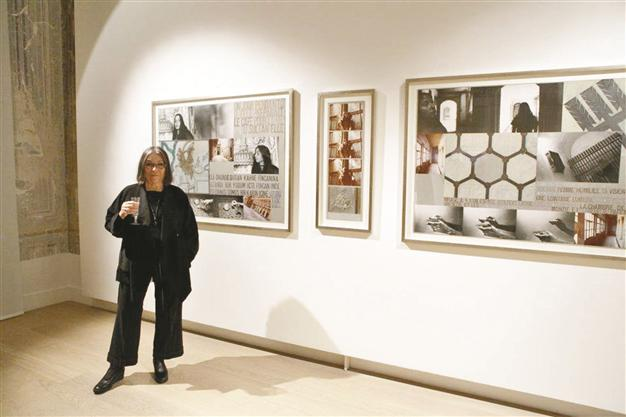Galerist exhibits solo show of Nil Yalter
Hatice Utkan ISTANBUL - Hürriyet Daily News

Nil Yalter uses a wide variety of techniques to
reflect various perspectives on women’s issues, gender and migration.
Depicting issues such as gender, identity and womanhood in a piece of art where different materials and media work together within it is a hard task. However, Nil Yalter has succeeded in doing so. She is perceived as one of the most important female artists of the century. Using a wide variety of techniques, she reflects various perspectives on women’s issues, gender and migration, combining video, drawings and photographs to produce just one piece.
Her latest show at Galerist Tepebaşı in Istanbul showcases a portfolio spanning almost 50 years and was curated by Dr. Necmi Sönmez. The exhibition presents a time tunnel through the century that exceeds the scope of an ordinary showing and aims to use specific frames by using the artist’s own themes together with the concepts of memory, time and interpretation, Sönmez said.
Time aspect of theexhibtionThe viewers can trace Yalter’s artistic development, gaining insight into how her work has evolved from paintings she did during the ‘60s and ‘70s to later pieces, which incorporate multimedia. “I took photos of the works and then I created 3-D works from those photos,” said Yalter. “That is why we named it 20th century and 21st century.”
For Yalter, this is the first time she has had the privilege of seeing both elements of old and new together in one place. This exhibition also gives the opportunity to Yalter to revive the old in contemporary times with technology. “That’s why the language of the exhibition is very good,” said Sönmez. Indeed, the most intriguing element of the exhibition is the content of the work itself and discovering how each piece binds together within time and space. After 42 years she revisiting the same forms to produce videos using computer supported animation programs, combining two versions of her works where she “used completely different techniques,” Sönmez said.
“When I first moved to Paris from Istanbul it was 1965 and I tried to saturate the thriving contemporary art scene of the city,” she said, but it took time. Yalter persisted, however, and “ArchiForme II (1968),” “2 Cubes (1966 -1969),” and “Optical Cubes” were all created as part of this era.
Yalter explores different aspects of gender and migratory issues and migration in her work. She aims to reflect what it is like to stay in a house for the whole day looking after a husband and children, and it was through exploration of this topic she discovered the wives of people who had migrated and lived in different countries. “I focused on the idea of being ‘confined.’ This is a broad topic. For example, sometimes a woman who stays at home all the time is confined, sometimes a woman who stays in a harem is confined, but all of them are being confined to an extent.”
Migration and cultureInvestigating one issue led Yalter to the next. She argued women also experience hard times when their husbands migrate to other countries. “Those women do not know any languages,” she said, “I have seen some women who have gone mad.”
The creation of “The headless woman or the belly dancer” within the Harem series shows a woman’s abdomen but never her head. This was a significant piece in Yalter’s engagement with political concerns and reflected her questioning of female identity more widely.
While she was researching shamanism she started to find out more about nomadic communities, prompting her to create an installation called “Topak Ev,” a nomad’s tent that is a study of private, public and feminine spaces.
“I found nomads who were living around Niğde and discovered that all of their relatives had migrated to other countries to find work. Interest in this field subsequently led me to produce pieces working with Turkish immigrants,” Yalter said.
